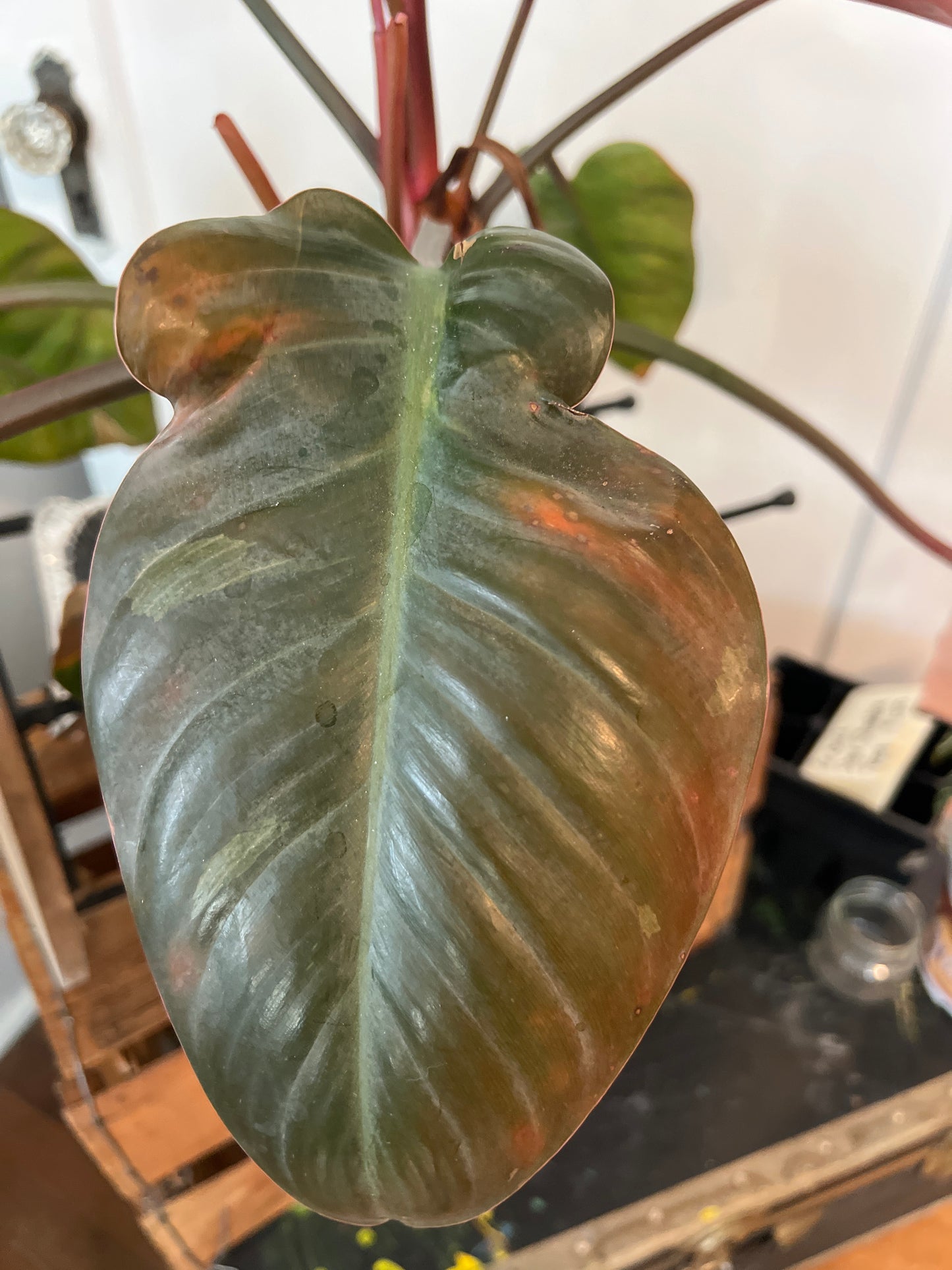Philodendron Pink Princess
Philodendron Pink Princess
Philodendron 'Pink Princess' is a highly sought-after tropical plant known for its stunning variegated leaves, featuring splashes of pink, deep green, and sometimes dark burgundy. This climbing philodendron is prized for its unique color combinations and is often grown as a houseplant, though it can be grown outdoors in tropical climates.
Plant Description:
- Foliage: The leaves are heart-shaped and feature a mix of green, dark burgundy, and pink. The pink variegation can vary from small splashes to large sectors of the leaf. Each leaf is unique in its coloring, with some being more predominantly pink than others.
- Growth Habit: 'Pink Princess' is a climbing or vining philodendron that benefits from support, such as a moss pole or trellis, to encourage vertical growth. If left unsupported, it will trail.
- Stems: The stems are also variegated, with pink hues that complement the colorful leaves.
Growing Conditions:
- Hardiness Zones: USDA zones 10-11 for outdoor planting. Most commonly grown as a houseplant in other regions.
- Height: Indoors, it can grow up to 2-4 feet (60 to 120 cm) in height when given proper support. Outdoors, in ideal tropical conditions, it may grow larger.
- Width: 2-3 feet (60 to 90 cm), depending on how it is pruned and trained.
- Sun Exposure: Prefers bright, indirect light. While it can tolerate lower light conditions, too little light will reduce the pink variegation, and the plant may revert to greener leaves. Avoid direct sunlight, as this can scorch the delicate pink parts of the leaves.
- Soil: Well-draining, rich potting soil is ideal. A soil mix designed for aroids (philodendrons, monsteras, etc.) with peat, perlite, and orchid bark will promote healthy root growth and drainage.
- Watering: Keep the soil consistently moist but not waterlogged. Water when the top 1-2 inches of soil feel dry. Overwatering can cause root rot, while underwatering may lead to wilting and dry leaves.
- Humidity: 'Pink Princess' thrives in high humidity, though it can adapt to average indoor humidity levels. Increasing humidity through misting or using a humidifier can help maintain healthy foliage.
- Temperature: Prefers temperatures between 65-80°F (18-27°C). Keep it away from cold drafts and temperatures below 55°F (13°C), as it is sensitive to cold.
Planting and Care Tips:
- Planting Time: 'Pink Princess' can be planted indoors year-round. If growing outdoors in a tropical climate, plant it in spring or summer when temperatures are warm.
- Support: Use a moss pole or trellis to help the plant climb. This will promote more vertical growth and larger, healthier leaves.
- Repotting: Repot every 1-2 years or when the plant becomes root-bound. Choose a pot that is 1-2 inches larger than the current one, ensuring good drainage.
- Fertilization: Feed with a balanced, water-soluble fertilizer every 4-6 weeks during the growing season (spring and summer). Reduce feeding in fall and winter when growth slows.
- Pruning: Prune the plant to control its size and shape, removing leggy or overgrown stems. You can also prune to encourage more branching and fuller growth.
- Variegation Maintenance: For consistent pink variegation, make sure the plant gets enough indirect light. If the plant produces all-green leaves, you can prune those stems back to encourage more pink growth.
Uses:
- Indoor Plant: 'Pink Princess' is primarily grown as a houseplant due to its striking variegation and climbing habit. It adds a pop of color to indoor spaces and is highly decorative.
- Tropical Gardens: In zones 10-11, 'Pink Princess' can be grown outdoors as part of a tropical garden or in large containers. It adds color and texture to shady spots in the garden.
- Climbing or Trailing Plant: Use it as a climbing plant with a moss pole indoors, or let it trail in hanging baskets or containers.
- Collectors' Plant: Due to its unique appearance, 'Pink Princess' is highly prized by plant collectors and indoor gardeners.
Native Range:
While the Philodendron 'Pink Princess' is a cultivated hybrid and not found in the wild, its parent species originate from the tropical rainforests of Central and South America. In the wild, philodendrons grow as climbing plants in the understory of forests, where they receive filtered light and high humidity.
---SHIPPING NOTICE PLEASE READ BEFORE PURCHASING LIVE PLANTS!---
We WILL NOT refund the purchase of or the shipping cost of live plants purchased with the intent to be shipped to states that do not authorize importing live plants or to states with restrictions! Purchases to these states will be held for 30 days for pick-up at our Slidell, Louisiana store and the shipping cost associated with these purchases will be held for the care of the plant while waiting to be picked up. All sales are final. If the plant(s) purchased are not picked up within 30 days from the date of order, these items will be returned to our sales inventory and you WILL NOT be refunded. Thank you for understanding these policies.
Due to regulations, certain states have restrictions on importing plants. Please review the list below to ensure you're not attempting to order any restricted plants in your area.
**Important Note:** We do not ship any plants outside the U.S.
State-Specific Restrictions - We ARE NOT responsible for any plant(s) that are not listed in these restrictions. Purchaser bears all responsibility for making sure the plant(s) they desire to purchase are not banned from being imported to the shipping state:
Arizona: Juglans spp.
California: Castanea spp., Juglans spp., Pinus spp., Quercus spp.
Colorado: Some counties restrict Prunus spp. Please verify your local county regulations.
Florida: Castanea spp., Cornus spp., Quercus spp., Cornus mas
Georgia: Vaccinium spp.
Hawaii: Pinus spp.
Idaho: Humulus lupulus, Mentha spp., Vitis spp.
Indiana: Fragraria spp., Rosa spp.
Kansas: Juglans spp.
Michigan: Abies spp., Vaccinium spp.
Montana: Pinus spp.
Nevada: Allium spp.
Mentha spp.
New Jersey: Rosa spp.
New York: Vitis spp.
Oregon: Allium spp., Castanea spp., Corylus spp., Humulus lupulus, Quercus spp., Sambucus nigra, Ulmus spp., Vaccinium spp., Vitis spp.
Texas: Juglans spp.
Washington: Allium spp., Castanea spp., Corylus spp., Humulus lupulus, Vaccinium spp., Vitis spp.
Wisconsin: Abies spp., Pinus spp., Picea spp., Mentha spp.
Additionally, we cannot ship plants in soil medium to the following states: AK, AL, AR, AZ, CA, HI, ID, KS, MS, MT, ND, NM, NV, OK, OR, SD, TX, UT, WA.
Couldn't load pickup availability


